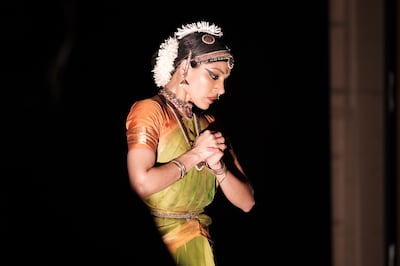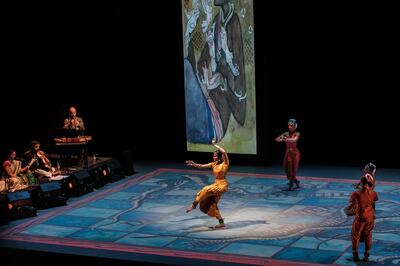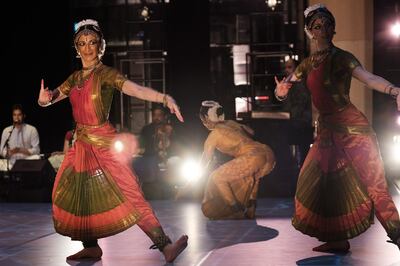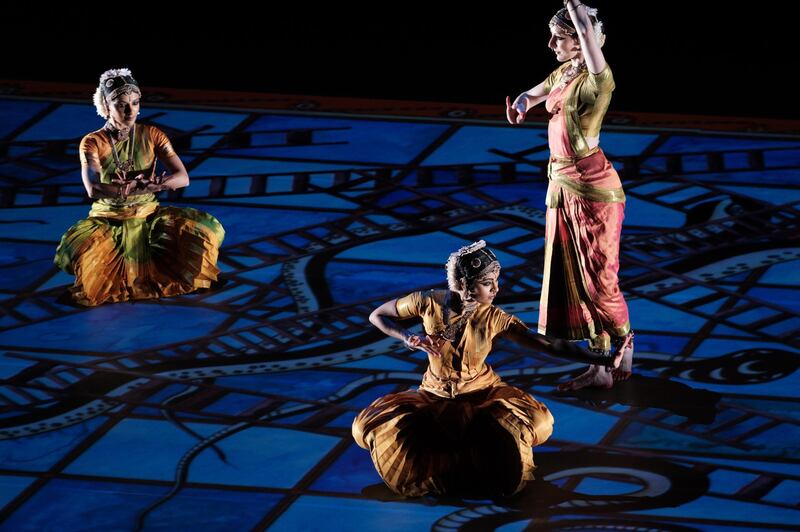Watching Written in Water, choreographed by the Minnesota-based Raagmala dance troupe at New York University - Abu Dhabi’s Arts Centre last night took me back in time. Bharatanatyam - a classical Tamil dance and the subcontinent’s oldest has been my long-abiding love and the performance reminded me of my own journey of re-discovering this most graceful art form.
I tied my first salangai (anklets) - worn by Indian classical dancers to perform intricate footwork to match a vocalist's beats - at the age of four. I was always the quirky one on stage. Short and skinny, with hair like a little boy, I cut an odd figure. Backstage, makeup artists struggled to attach the jadai (braided hair extensions) to my sparse hair and eventually settled to pinning a strand of jasmine to the crown of my head. Unlike the elegant dancers, draped in silk, making them appear like apsaras (godly nymph-like dancers of Hindu mythology), with their bodies set to hour-glass perfection according to the sensibilities of centuries of Indian aesthetic, I had an ungainly gait, with no amount of padded fabric helping me achieve celestial perfection. However, despite my lack of stage glamour, I gave myself over to dance and for all my visible flaws, remained a dedicated student.

However, our move to Bahrain at the age of eight put a slow end to my learning. My mother and I worried about finding a good teacher and though I performed on stage for a couple of years, I gave it up for lack of training. The salangai remained in my room and there were days I would open the box, kiss the anklets and put them back with a sigh. I grew out of my silk dancer's clothes and they remained in the cupboard, a relic of my childhood.
However, my move to Dubai last year renewed my search for a good teacher and I started lessons again, only to give up when my work as a journalist took up much of my time.
This is why sat in the audience last night, watching the mother-daughter duo perform with their troupe made me realise it was never too late to learn.
Ranee Ramaswamy, 65, founded the dance academy when she was 40 having earlier given up the dance form when she to moved to the US, as she was expected to focus on her family.

Trained under the iconic dancer Alarmel Valli in Chennai, Ranee and her daughter Aparna, 41, now manage a team that performs across the US, UK, the UAE as well as India. Both Ranee and Aparna are not just background managers but actually perform in all their shows. Watching them last night, moving to a beautiful meld of Iraqi, jazz and Carnatic (southern Indian) music by composer Amir El Saffar was an absolute treat.
The Carnatic musician's rendition perfectly yielded to Amir’s trumpet, and soft, moving vocals in Arabic. It warmed me to see the audience clap in between various segments, which was unusual for me as back in Tamil Nadu (India’s southern-most state), a Bharatanatyam performance is a sober event, performed as a prayer dance and treated very reverentially by the audience. Tamils, by nature remain conservative when it comes to safeguarding their culture and as a result Bharatanatyam remains one of the most guarded dance forms, very rarely, if ever allowing innovations on stage. What Ranee and Aparna have done is keep form at its purest, while allowing the Sufi music to lend to one of our greatest dances a truly global connect.
My most moving moment of the night came towards the end when the Carnatic vocalist ended the performance by singing in Tamil, "Anaithum neeye, anaithin porulum neeye", which translated means "Everything is you, the meaning of everything and matter is you." A line, straight out of the Bhakti and Sufi movements that characterised 15th century subcontinent, making sweeping changes to the dogmatic nature of religion and marking the emergence of India as one of the most spiritual places on earth.
Between the fifteenth and seventeenth centuries, the Tamil-speaking regions saw a slow movement towards devotional worship on the essence of God. Brushing aside centuries of puritanical Hinduism, the devotees of what is now called the Bhakti (devotion) movement immersed themselves in song and poetry, often sung in local languages in contrast to worship that used largely Sanskrit - a language incomprehensible to the common man and used only by Hindu clergy. The Bhakti devotees took their ideas northward only to meet, with the arrival of Islam in the subcontinent, the Sufi mystics of the northern plains. The amalgamation of their ideas gave birth some of the most beautiful poetry in Urdu - a language that grew from the mixing of khariboli, the lingua franca of northern India and Persian, the language of the Mughal courts. It also led to the birth of Sikhism, a religion that embraces aspects of the subcontinent's diverse Hindu faiths with Islamic tenets.

Yesterday's performance was a beautiful synthesis of the Bhakti and Sufi movements and made me realise how much we could leverage art, even those guarded by purists by allowing it to match the rhythm of our times.
Last week, after watching an eighties Tamil film Sindhu Bhairavi about a fallen Carnatic musician, who finds his groove, I messaged my Bharatanatyam teacher saying I was thinking of coming back to class. In the film, the reformed musician finds himself back on stage and sings an invocation to Kalaivani, the Tamil word for Goddess Lakshmi, the patron of arts (kalai) in Hindu tradition. "I want dance to this, I want to come back," I had texted her.
On my way out of the NYU arts centre auditorium, with anaithum neeye ringing in my ears, I decided it was time to wear my salangai again. I was going back.











